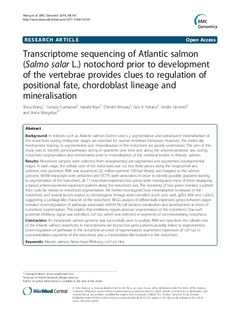| dc.description.abstract | Background: In teleosts such as Atlantic salmon (Salmo salar L.), segmentation and subsequent mineralisation of the notochord during embryonic stages are essential for normal vertebrae formation. However, the molecular mechanisms leading to segmentation and mineralisation of the notochord are poorly understood. The aim of this study was to identify genes/pathways acting in gradients over time and along the anterior-posterior axis during notochord segmentation and immediately prior to mineralisation of the vertebral bodies in Atlantic salmon.
Results: Notochord samples were collected from unsegmented, pre-segmented and segmented developmental stages. In each stage, the cellular core of the notochord was cut into three pieces along the longitudinal axis (anterior, mid, posterior). RNA was sequenced (22 million pair-end 100 bp/library) and mapped to the salmon genome. 66569 transcripts were predicted and 55775 were annotated. In order to identify possible gradients leading to segmentation of the notochord, all 71 notochord-expressed hox genes were investigated, most of them displaying a typical anterior-posterior expression pattern along the notochord axis. The clustering of hox genes revealed a pattern that could be related to notochord segmentation. We further investigated how mineralisation is initiated in the notochord, and several factors related to chondrogenic lineage were identified (sox9, sox5, sox6, tgfb3, ihhb and col2a1), suggesting a cartilage-like character of the notochord. KEGG analysis of differentially expressed genes between stages revealed down-regulation of pathways associated with ECM, cell division, metabolism and development at onset of notochord segmentation. This implies that inhibitory signals produce segmentation of the notochord. One such potential inhibitory signal was identified, col11a2, which was detected in segments of non-mineralising notochord.
Conclusions: An incomplete salmon genome was successfully used to analyse RNA-seq data from the cellular core of the Atlantic salmon notochord. In transcriptome we found; hox gene patterns possibly linked to segmentation; down-regulation of pathways in the notochord at onset of segmentation; segmented expression of col11a2 in non-mineralised segments of the notochord; and a chondroblast-like footprint in the notochord. | nb_NO |
